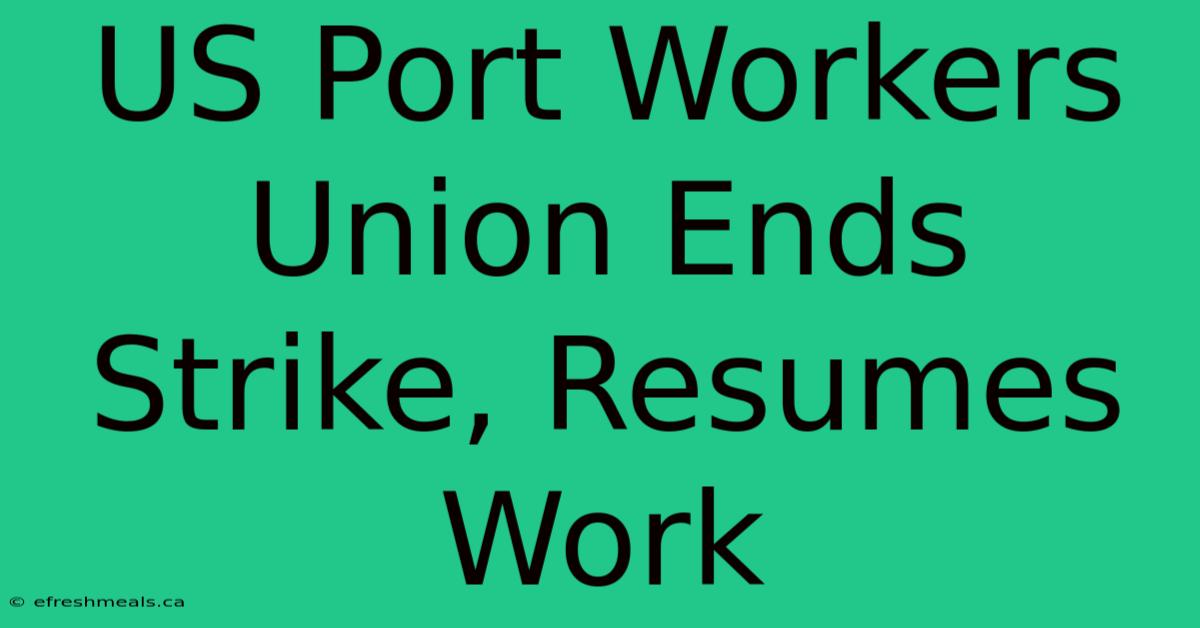US Port Workers Union Ends Strike, Resumes Work

Discover more detailed and exciting information on our website. Click the link below to start your adventure: Visit Best Website nimila.me. Don't miss out!
Table of Contents
US Port Workers Union Ends Strike, Resumes Work: What Does This Mean for the Economy?
Editor’s Note: The recent strike by the International Longshore and Warehouse Union (ILWU) at US West Coast ports has ended, with workers returning to their jobs. This resolution brings much-needed relief to supply chains and businesses across the country.
Why It Matters: This strike had the potential to significantly disrupt the US economy, impacting everything from consumer goods to manufacturing and agriculture. With the strike now over, what are the key takeaways for the economy?
Key Takeaways:
| Takeaway | Description |
|---|---|
| Relief for Supply Chains | The strike's end removes a significant bottleneck in the US supply chain, allowing for the efficient flow of goods and products. |
| Economic Boost | The resumption of work at the ports will boost economic activity, as businesses can now receive their shipments and resume normal operations. |
| Reduced Inflationary Pressure | With the smooth flow of goods restored, the strike's potential to drive up prices is mitigated, potentially easing inflationary pressures. |
US Port Workers Union Ends Strike, Resumes Work
The ILWU, representing approximately 22,000 dockworkers, has ended their strike after reaching a tentative agreement with the Pacific Maritime Association (PMA), which represents the port employers. This agreement marks a significant victory for both sides, as it avoids further disruptions to the US economy.
Key Aspects of the Agreement:
- Wage Increases: Workers will receive significant wage increases, totaling 32% over the six-year agreement.
- Healthcare Benefits: The agreement includes improved healthcare benefits for workers and their families.
- Retirement: Workers will see an increase in their retirement benefits.
- Automation: The agreement includes provisions regarding automation in the ports, addressing worker concerns about job security.
The Impact of Automation
The inclusion of automation provisions in the agreement is a key aspect to consider. While it's meant to address worker concerns, it also raises questions about the future of dockworker jobs. The adoption of automation technologies could lead to changes in the workforce composition, potentially impacting employment levels in the long run.
The Future of the Ports:
The resolution of the strike is a positive development for the US economy. It allows for the free flow of goods, supports economic growth, and potentially mitigates inflationary pressures. However, the issue of automation remains a crucial factor to monitor in the future. The agreement's provisions regarding automation will likely be closely scrutinized by both workers and employers in the coming years, potentially shaping the future of labor practices in the port industry.
FAQ
Q: What were the key demands of the ILWU during the strike? A: The ILWU's key demands included significant wage increases, improved healthcare benefits, increased retirement benefits, and safeguards against job losses due to automation.
Q: What were the main concerns of the PMA during the strike? A: The PMA's primary concerns were the cost of the contract, the potential for disruptions to the supply chain, and the impact of automation on the workforce.
Q: How will the agreement impact consumers? A: The agreement is likely to have a positive impact on consumers by reducing the potential for price increases and ensuring a steady supply of goods.
Q: What are the potential long-term consequences of the agreement? **A: **The agreement's long-term consequences will depend on how automation is implemented and how the workforce adapts to these changes. It is crucial to monitor the impact of automation on employment levels and worker well-being in the coming years.
Tips for Businesses
- Monitor supply chain disruptions: Stay informed about potential disruptions in the global supply chain and adjust operations accordingly.
- Diversify sourcing: Reduce reliance on single-source suppliers to minimize disruption risks.
- Build strong relationships with suppliers: Foster close partnerships with suppliers to ensure consistent communication and collaboration.
- Optimize inventory management: Implement efficient inventory management systems to minimize stockouts and ensure timely delivery of goods.
Summary by US Port Workers Union Ends Strike, Resumes Work
The resolution of the ILWU strike is a positive development for the US economy. It removes a major bottleneck in the supply chain, allows businesses to resume normal operations, and potentially helps ease inflationary pressures. However, the issue of automation remains a significant concern. The agreement's provisions regarding automation will require careful monitoring and management to ensure a smooth transition and mitigate any potential negative impacts on the workforce.
Closing Message: The end of the US port workers strike is a testament to the power of negotiation and compromise. While the agreement addresses immediate concerns, the long-term impact of automation on the port industry remains a crucial factor to consider. It's essential for both workers and employers to engage in constructive dialogue to address these challenges and ensure a sustainable future for the workforce and the US economy as a whole.

Thank you for visiting our website wich cover about US Port Workers Union Ends Strike, Resumes Work . We hope the information provided has been useful to you. Feel free to contact us if you have any questions or need further assistance. See you next time and dont miss to bookmark.
Featured Posts
-
East Coast Gulf Coast Port Workers Resume Work
Nov 01, 2024
-
Thursday Night Football Texans Jets
Nov 01, 2024
-
Celtics Pacers Loss Consistency And Defense Issues
Nov 01, 2024
-
Top 3 Halloween Costumes For Pets
Nov 01, 2024
-
October 31 2024 Whats Inside This Edition
Nov 01, 2024
